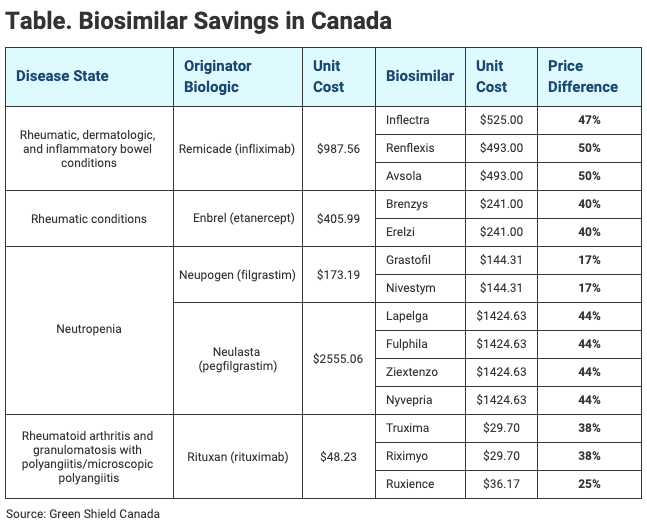- Bone Health
- Immunology
- Hematology
- Respiratory
- Dermatology
- Diabetes
- Gastroenterology
- Neurology
- Oncology
- Ophthalmology
- Rare Disease
- Rheumatology
Green Shield Canada: Preferential Status Is Vital to Biosimilar Uptake
To overcome provider and patient preferences for brand originators, there has to be more of an incentive to use biosimilars, explains Nedzad Pojskic, PhD, MSc, Green Shield Canada.
Based on the success of a biosimilar switching program, Nedzad Pojskic, PhD, MSc, vice president of Pharmacy Benefits Management for Green Shield Canada, detailed why payers should become bigger advocates for biosimilar uptake, at the Festival of Biologics USA meeting.
Canada ranks third in the world in per capita spending on drugs ($1012 vs $1324 in Switzerland and $1457 in the United States), he said, explaining the need for biosimilar savings.
“I think it's really important to recognize that as payers in this country, we have to be explicit around being leaders in educating various stakeholders, whether they be physicians, other sorts of players in the system, patients, or those in leadership roles, to support a viable biosimilar market and to move forward,” said Pojskic.
Although Canadian provinces such as British Columbia and Alberta have begun executing biosimilars switching initiatives, Pojskic noted that Green Shield Canada was the first payer to have a policy that preferred biosimilars to originators.
Under the program, patients with a number of rheumatic conditions are either started on or switched to biosimilar versions of infliximab, etanercept, and rituximab, whose respective originator brands are Remicade, Enbrel, and Rituxan. Other biosimilar switches are expected with future program expansions.
How Payers Have Influence
Pojskic said that, for him, one of the most important lessons to come out of implementing a biosimilar transition program such as this was that payers are the real “gatekeepers” to biosimilar uptake.
“Evidence has shown us time and again that when payers allow open access to an originator and a biosimilar with no preferential policies for biosimilars, the uptake naturally flows to the originators….However, with more aggressive policies that target a sustainable biosimilar market and the uptake of biosimilars in preferential fashion, we start to see payers being a really important part of this equation,” he said.
When biosimilars and originators are treated equally on the formulary, patients and providers flock to originator products because they have historical comfort with using the dominant brands. As a result, biosimilar uptake occurs very slowly, Pojskic said.
So far, Green Shield Canada’s program is a success, generating an average of $8500 in savings per member annually. Of the patients involved in the program, 55% transitioned to a biosimilar and 14% stayed on the originator but were billed for the price of the biosimilar, which resulted in reduced costs, Pojskic noted.
Pojskic also said that Green Shield Canada made it a priority to work with patients to ensure comfort with biosimilar switching, and this was successful. He reported that patients understood and were receptive to the change, had talked with their physicians about transitioning, and appreciated the support and aid given by nurses.
Current State of Canadian Biologics
The Canadian health care system primarily functions as a Medicare-like structure that covers most aspects of hospital and physician care. However, pharmaceuticals are different in that they are funded both privately and publicly. Canada spent $39.8 billion on drugs in 2018, and of that, $12.30 billion and $14.33 billion was privately and publicly funded, respectively, and out-of-pocket costs for pharmaceuticals were $13.10 billion, Pojskic said.
The share of total pharmaceutical costs generated by biologics spending has grown year-over-year, from 20% in 2015 to 24.7% in 2019. Pojskic said that he expects this number to grow as more biologics enter the market.
As biosimilars have entered the market, discounts from originator costs have ranged from 17% for filgrastim biosimilars to 50% for some infliximab biosimilars, he said (Table).
Click to enlarge.

Canada is one of the largest purchasers of originator infliximab, but at the end of 2018, uptake of infliximab biosimilars was only at 8% of total use, slightly above the United States (7%) but significantly trailing Norway (98%), Poland (96%), the United Kingdom (92%), Austria (89%), and Italy (79%), according to Pojskic’s presentation.
Pojskic said several factors pose barriers to biosimilar uptake in Canada:
- There are no interchangeability policies (pharmacists cannot simply substitute biosimilars without physician approval)
- Payer policies offer reimbursement for biosimilars without making them preferred products
- Switching to biosimilars was not encouraged until recently
- Originator manufacturers interfere with biosimilar uptake
Transition Program Challenges
Pojskic said a major hurdle that had to be overcome when implementing the biosimilar transition program was addressing the common concern that there is not enough evidence to support the safety of biosimilar switching.
To combat this, Green Shield Canada produced a systematic review of studies showing that switching between originators and biosimilars was safe and effective. The review encompassed 178 studies, of which 140 were based on real world evidence, and included data on 21,000 patients and 10 biologic agents.
“There's plenty of evidence to support biosimilar transitioning and it all points in exactly the same direction. We knew that this evidence was more than enough to safely engage in biosimilar transitioning and to create a program,” said Pojskic.
Unlocking Biosimilar Potential in Specialty Pharmacies With Legislative Support, Formulary Changes
April 24th 2025Sophia Humphreys, PharmD, MHA, BCBBS, emphasized that legislative support and formulary changes are crucial for overcoming unique challenges in specialty pharmacies and driving the growth of biosimilar adoption, which has significant cost saving potential in the next decade.
Will the FTC Be More PBM-Friendly Under a Second Trump Administration?
February 23rd 2025On this episode of Not So Different, we explore the Federal Trade Commission’s (FTC) second interim report on pharmacy benefit managers (PBMs) with Joe Wisniewski from Turquoise Health, discussing key issues like preferential reimbursement, drug pricing transparency, biosimilars, shifting regulations, and how a second Trump administration could reshape PBM practices.
The Growing Impact of Biosimilars in IBD Care
April 23rd 2025Biosimilars are proving to be a game-changing solution in the fight against inflammatory bowel disease (IBD), offering a cost-effective alternative to biologics with similar efficacy and safety, while innovative drug delivery systems promise to further enhance treatment outcomes and accessibility for millions worldwide.
Biosimilars Gastroenterology Roundup for November 2024—Podcast Edition
December 1st 2024On this episode of Not So Different, we discuss market changes in the adalimumab space; calls for PBM transparency and biosimilar access reforms grew; new data for biosimilars in gastroenterology conditions; and all the takeaways from this year's Global Biosimilars Week.
BioRationality: EMA Accepts Waiver of Clinical Efficacy Testing of Biosimilars
April 21st 2025Sarfaraz K. Niazi, PhD, shares his latest citizen's petition to the FDA, calling on the agency to waive clinical efficacy testing in response to the European Medicines Agency's (EMA) efforts towards the same goal.
Biosimilar and Biologic Use Increasing in Greek Patients With IBD
April 19th 2025A retrospective study from a single inflammatory bowel disease (IBD) center in Greece reported that from 2018 to 2022, the use of biologics increased by 28% yearly, and the proportion of patients using biosimilars grew from 33% to 67%.

